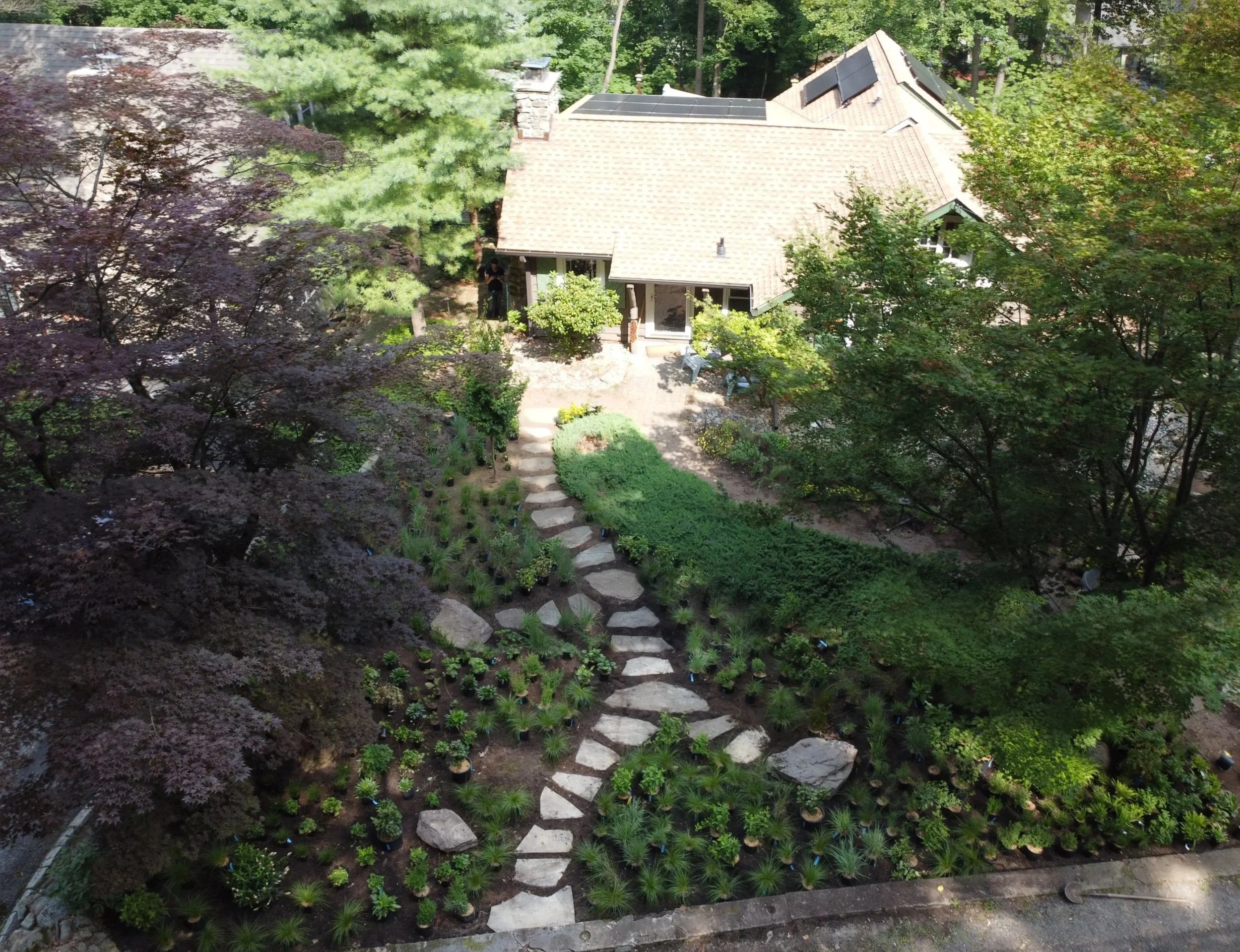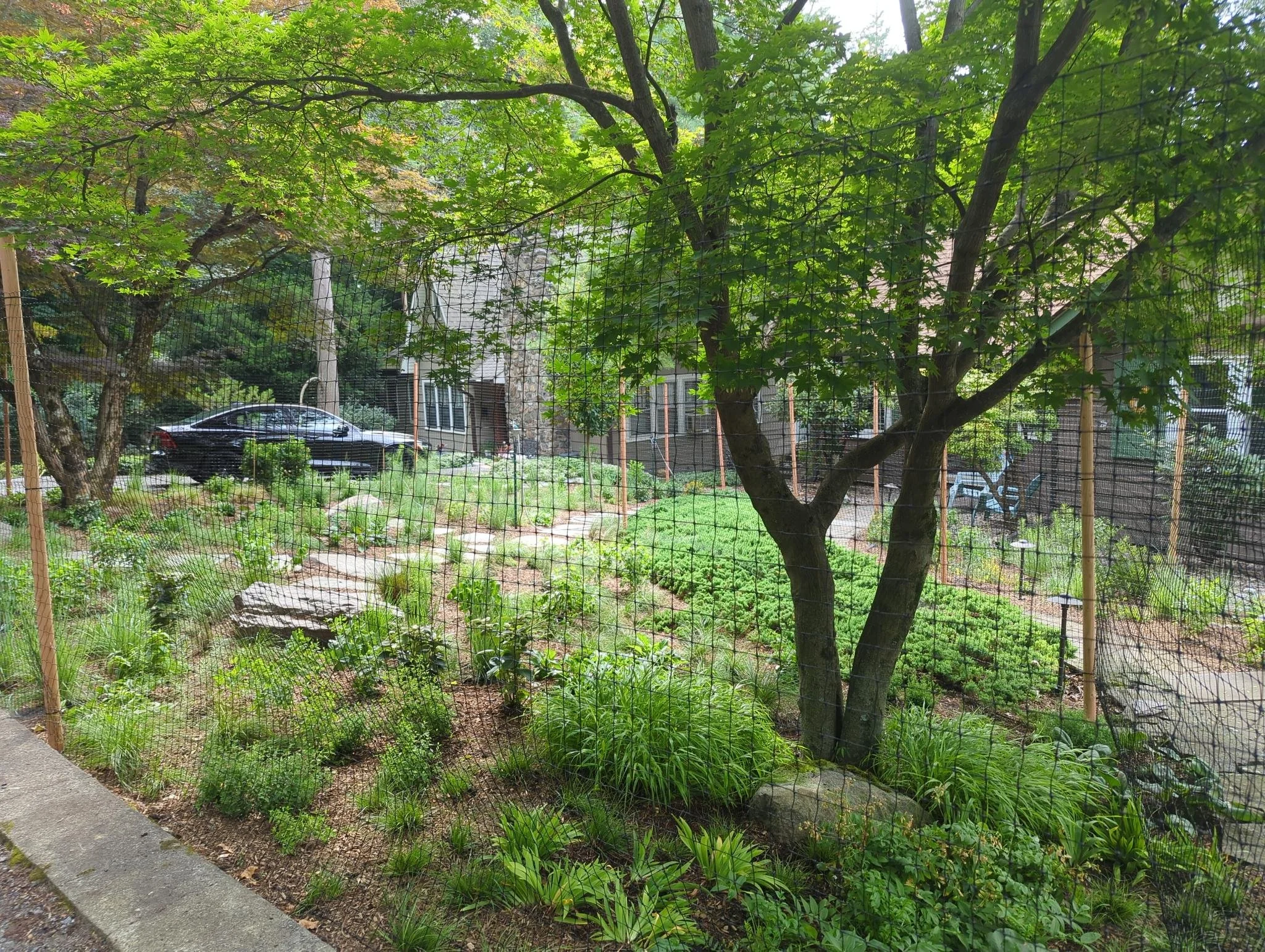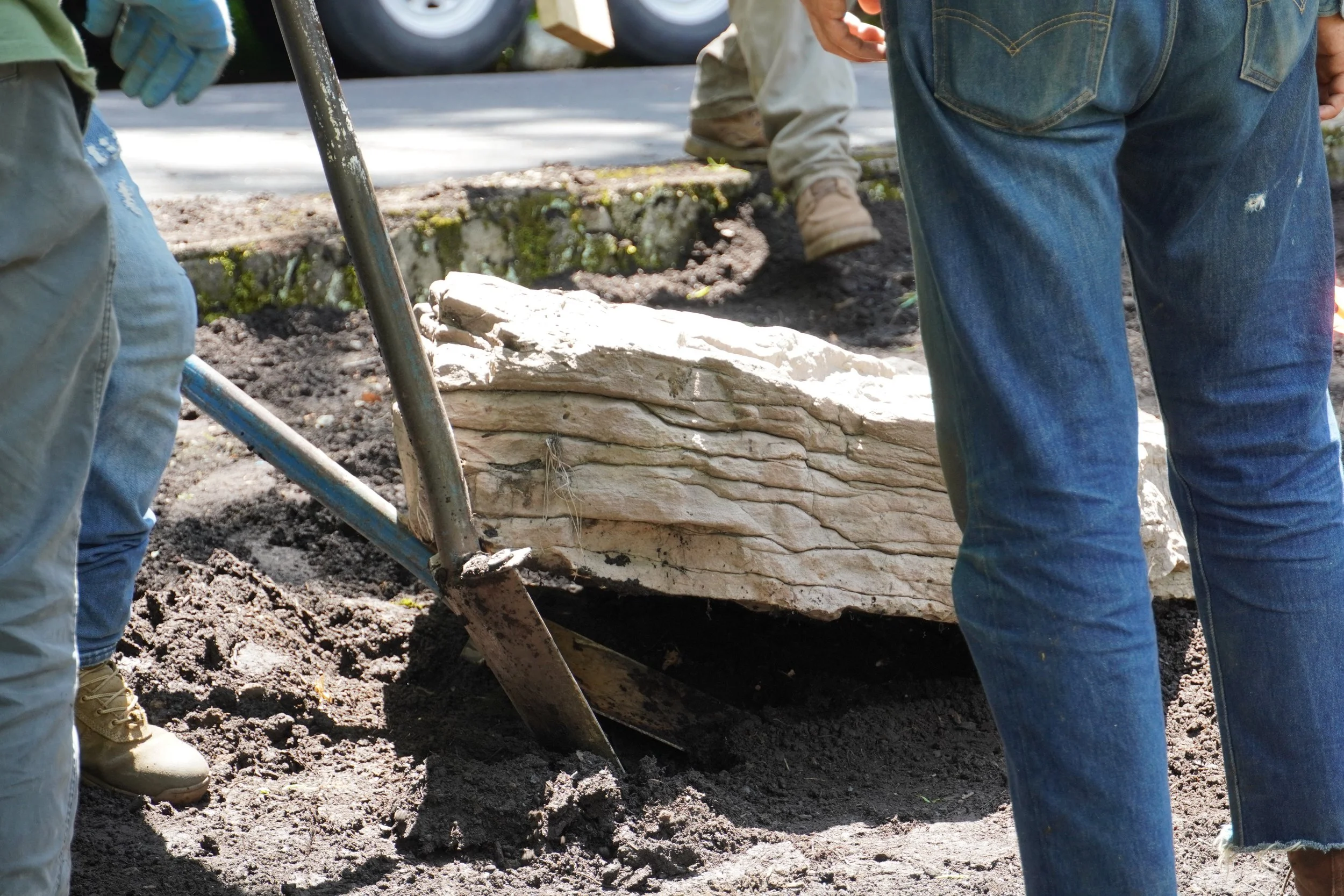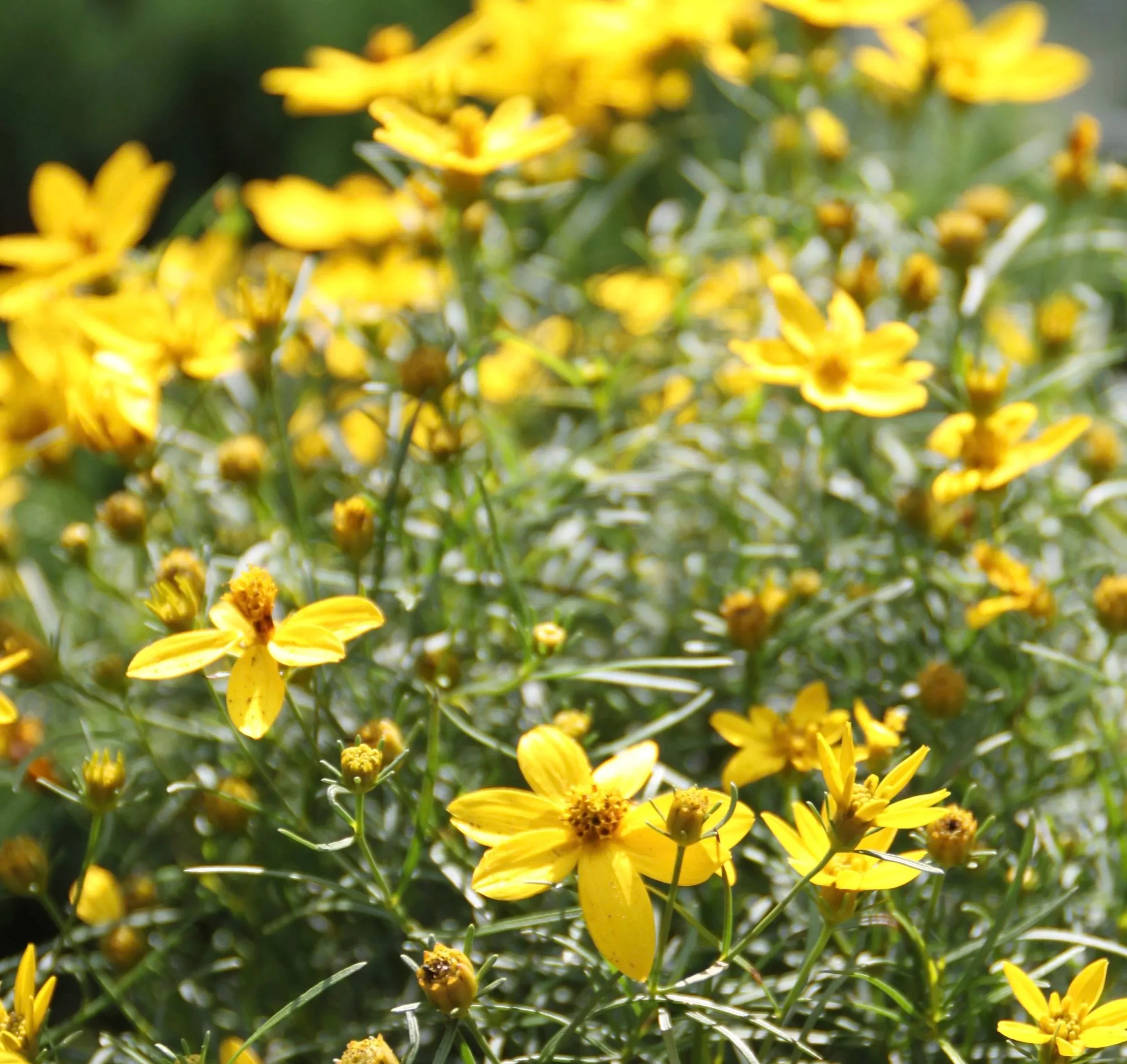The Generational Garden
A New Jungle to Explore
Just days after the last native perennials were tucked into the earth and the temporary deer fence staked into place, a young girl stepped into the garden for the first time. Only two years old, but already full of curiosity, she moved slowly across the wide flagstone path, pausing to peek beneath ornamental grasses and brush her hand across blooming coreopsis. She climbed one of the large boulders and surveyed the scene.
“The jungle,” she called it.
She may not know it yet, but this jungle is a place she’ll return to again and again. A space she’ll grow up alongside.
A space shaped by her family, and one that will, in turn, help shape her.
Image Caption: Aerial view of curved flagstone path and newly planted beds
The Opportunities
Designing landscapes with multiple generations in mind offers something that goes beyond beauty and ecological function.
It opens the door to shared experience and collective memory.
This garden, and those who continue to explore it, become a vessel for four kinds of opportunity:
1. Experiencing. Regular visits, slow walks, quiet time, observing, noticing. These are critical tools in building relationships with people and place. The garden becomes a familiar rhythm in daily life, a designated space that invites consistent presence.
2. Learning. From the names of flowers to the calls of birds, every inch of the garden is an informal classroom. For curious scientists young and old, it's a place to witness succession, adaptation, and seasonal change. It’s a slow-motion botany and ecology lesson throughout the year (and all without tuition!).
Image Caption: From the street, the new garden welcomes neighbors and pollinators alike with a dense, layered mix of native perennials, trees, and shrubs. Temporary deer netting helps protect the garden in its first few seasons of establishment.
3. Co-Creating. A garden is shaped over seasons: new cuttings, placed stones and art pieces, shared ideas, planted seeds. Here, co-creation means a space open to change, layered with care and expression. Each gesture becomes part of a living dialogue, guiding the way towards generational healing and belonging.
4. Passing It On. Gardens carry memory. They become places where stories are shared, traditions take root, and meaning accumulates over time. When designed for continuity, a garden becomes a site of cultural memory; a place to mark seasons, gather together, and sync up with the natural rhythms around us.
By Design
The design work focused on making these generational connections tangible. Every element was chosen to support ecological function and invite participation, wonder, and rest.
Steppers and Boulders
Large, locally reclaimed bluestone steppers guide movement through the space; wide and level enough for grandparents, playful enough for granddaughters. Sizeable boulders define moments of pause and add opportunity for art and reflection. They’re perches, landmarks, pedestals, and invitations to stay a while.
Image Caption: Placing the stone with teamwork and precision.
Shade and Screening
The dense and strategically placed native plantings provide a sense of soft enclosure. As the grasses and forbs fill in together, this garden won’t wall off the world, but gently filter out the adjacent road and its noise, persistent sunlight, and constant views of/to the neighbors. The trees and large shrubs will provide both visual structure and shade, all while framing the view of the sky.
Dense, Layered Native Plantings
Six hundred and eleven native trees, shrubs, perennials, and grasses fill the beds, selected for their ability to resist deer, tolerate drought, and support habitat. Density and biodiversity are tools for ecological function, yes, but also to define pathways, soften edges, and bring seasonal variety to the whole space; like watching slow-motion fireworks throughout the year.
Views To and From the House
The beds and heights of plants were shaped in conversation with the home’s architecture, framing the Craftsman-style entryway and guiding visitors toward the front door. From inside, every window offers a view into the garden: an ever-shifting display of movement and bloom.
Image Caption: The woodland entry garden takes shape with a carefully arranged stone path and a palette of native grasses, shrubs, and groundcovers awaiting their final placement.
The Results
A New Kind of Curb Appeal
Complementing nearby woodlands but bold enough to turn heads, this front yard now mirrors the grace of the home it frames. What was once lawn and mulch beds is now layered with color and motion. Many neighbors have already paused mid-walk to ask questions. The garden starts conversations before anyone reaches the door.
Low Environmental Impact
This was a hands-on project built with teamwork and care. Native plants were grown locally. Stone was reclaimed nearby. Most work was done by hand, and site grading was only lightly adjusted. We repurposed materials, reduced emissions, and minimized disruption by meeting the land where it was.
Image Caption: As summer unfolds, the newly planted woodland garden begins to establish. A winding stone path leads through clusters of native greenery, while a temporary fence protects tender growth from curious deer. The layout starts to reveal how the space welcomes both people and pollinators.
Ecological Function
The landscape now supports life on many levels. It slows and cycles the water, it rebuilds the soil, it stabilizes slopes from erosion, and it provides year-round food and shelter for pollinators, birds, and other lovely critters. It provides all its residents with edibles, medicinals, habitat, and fertile ground for mutuality and collective succession.
Fostering Relationships
This garden holds space for quiet observation, for story and celebration, for caretaking across generations. It invites relationship-building between family and neighbors, between art and meaning, between cycles and ceremony, between residents and the land they rely on.
Looking Forward
A few mornings after the last plants were settling in, the young explorer stepped outside again, trailed by her grandparents. She wandered between the grasses, paused to watch a bee move from bloom to bloom, and climbed her favorite boulder to look out over the jungle.
One day, when she’s ready to name the plants and tally the pollinators, we’ll hand her a clipboard and a data sheet.
But for now, she’s doing the most important thing:
getting to know the place.
Image Caption: Looking inward from the street, the entryway garden blends new
plantings and sculptural stone to offer an ecological and welcoming transition to the home.
Opportunity is in every landscape.
From the ground up,
Design Ecosystems with us.
Related Field Journal Audioessay
What the Lawn Remembers (~12min Listen)






